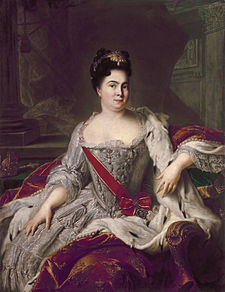Catherine I of Russia
| Catherine I | |||||
|---|---|---|---|---|---|

Portrait of Catherine by Nattier
|
|||||
| Empress and Autocrat of All the Russias | |||||
| Reign | 8 February 1725 – 17 May 1727 | ||||
| Coronation | 7 May 1724 (crowned as co-ruler) | ||||
| Predecessor | Peter I | ||||
| Successor | Peter II | ||||
| Empress consort of All the Russias | |||||
| Tenure | 22 October 1721 – 8 February 1725 | ||||
| Born |
15 April 1684 Latvia |
||||
| Died | 17 May 1727 (aged 43) Saint Petersburg, Russian Empire |
||||
| Burial | Peter and Paul Cathedral | ||||
| Spouse | Peter I of Russia | ||||
| Issue among others ... |
Anna, Duchess of Schleswig-Holstein-Gottorp Elizabeth, Empress of Russia |
||||
|
|||||
| House | Romanov | ||||
| Father | Samuel Skowroński | ||||
| Mother | Elisabeth Moritz | ||||
| Religion |
Russian Orthodox prev. Lutheran |
||||
| Signature |  |
||||
| Full name | |
|---|---|
|
Polish: Marta Helena Skowrońska Russian: Marfa Samuilovna Skavronskaya |
Catherine I (Russian: Екатери́на I Алексе́евна, tr. Yekaterina I Alekseyevna, born Polish: Marta Helena Skowrońska, later known as Marta Samuilovna Skavronskaya; 15 April [O.S. 5 April] 1684 – 17 May [O.S. 6 May] 1727) was the second wife of Peter the Great and Empress of Russia from 1725 until her death.
The life of Catherine I was said by Voltaire to be nearly as extraordinary as that of Peter the Great himself. There are no documents that confirm her origins. Said to have been born on 15 April 1684 (o.s. 5 April), she was originally named Marta Helena Skowrońska. Marta was the daughter of Samuel Skowroński, later spelt Samuil Skavronsky, a Roman Catholic peasant from the Polish-Lithuanian Commonwealth, who in 1680 married Dorothea Hahn at Jakobstadt. Her mother is named in at least one source as Elisabeth Moritz, and there is debate as to whether her father was a Swedish officer. It is likely that two stories were conflated, and Swedish sources suggest that the Elizabeth Moritz story is probably incorrect. Some biographies state that Marta's father was a gravedigger and handyman, while others speculate that he was a runaway landless serf.
Marta's parents died of the plague around 1689, leaving five children. According to one of the popular version, at the age of three Marta was taken by an aunt and sent to Marienburg (the present-day Alūksne in Latvia, near the border with Estonia and Russia) where she was raised by Johann Ernst Glück, a Lutheran pastor and educator who was the first to translate the Bible into Latvian. In his household she served as a lowly servant, likely either a scullery maid or washerwoman. No effort was made to teach her to read and write and she remained illiterate throughout her life.
...
Wikipedia
